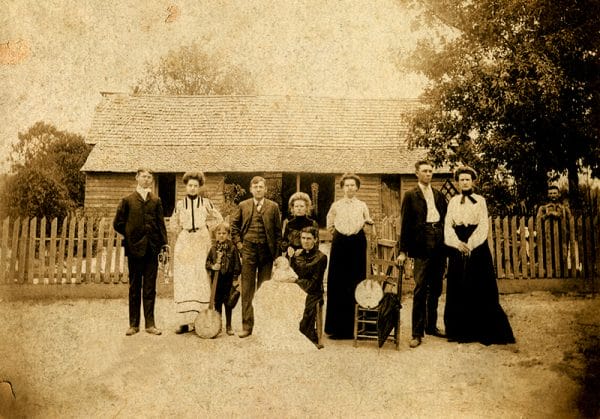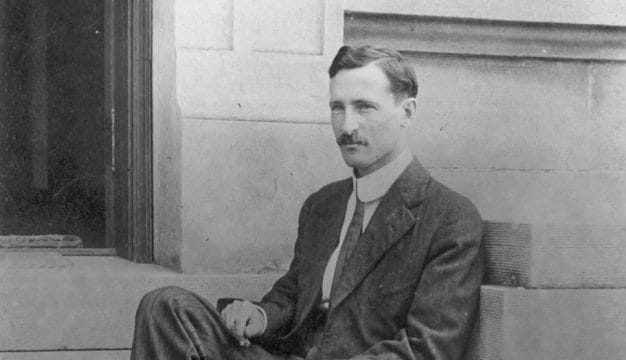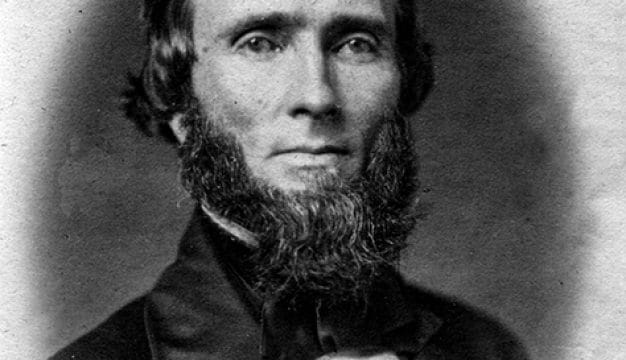Denson Edition of The Sacred Harp
The Denson Edition of The Sacred Harp (1991), or the “Denson Book” as it is generally called, is the most widely used of the hardback “old song” books used at shape-note congregational singings in churches throughout Alabama. Published first by the Sacred Harp Publishing Company, founded by Alabamian Tom Denson in 1933, the Denson Edition continues to have strong Alabama ties in its later revisions, with Alabamians making key contributions to the 1991 edition.
 Denson Family
The “sacred harp” is the human voice, and shape-note singing is an unaccompanied a capella style of performance. It traces its roots back to the tradition of using shapes and syllables to learn musical notes in eleventh-century Italy. During the eighteenth-century in New England, singing teachers such as William Billings (composer of “The Easter Anthem” and “Rose of Sharon”) initiated a distinctly American tradition of shape-note singing. Shape notes are designed to make the music quickly accessible to all singers, whether they can read music or not. Instead of using the traditional do-re-mi-fa-so-la-ti-do system, some singing teachers taught only four syllables (fa-so-la-fa-so-la-mi-fa) with four shapes: right triangle, circle, rectangle, and diamond; indeed, shape-note singing is also called “fasola” singing. This would become the system used in The Sacred Harp.
Denson Family
The “sacred harp” is the human voice, and shape-note singing is an unaccompanied a capella style of performance. It traces its roots back to the tradition of using shapes and syllables to learn musical notes in eleventh-century Italy. During the eighteenth-century in New England, singing teachers such as William Billings (composer of “The Easter Anthem” and “Rose of Sharon”) initiated a distinctly American tradition of shape-note singing. Shape notes are designed to make the music quickly accessible to all singers, whether they can read music or not. Instead of using the traditional do-re-mi-fa-so-la-ti-do system, some singing teachers taught only four syllables (fa-so-la-fa-so-la-mi-fa) with four shapes: right triangle, circle, rectangle, and diamond; indeed, shape-note singing is also called “fasola” singing. This would become the system used in The Sacred Harp.
As America expanded, the tradition moved south and west with the frontier. Two collaborating singing teachers (and brothers-in-law) in Spartanburg, South Carolina, William (“Singing Billy”) Walker and Benjamin Franklin White, came to a disagreement when, in 1835, Walker published his song book, Southern Harmony (which introduced hymns such as “Amazing Grace” to mainline Protestants), without giving credit to White. White moved to Georgia, where in 1844 he produced the first edition of The Sacred Harp, in collaboration with E. J. King. Popular songbooks that followed included the 1859-1860 revision of The Sacred Harp; the 1866 and 1873 editions of Walker’s Christian Harmony; the 1902 B. F. White Sacred Harp, edited by W. M. Cooper; and the 1911 Original Sacred Harp, edited by Joe S. James.
In 1933, the Sacred Harp Publishing Company, organized by Alabama singing school instructor Tom Denson, bought the rights to The Sacred Harp. In 1936, the company released the first Denson Edition of The Original Sacred Harp. In 1971, the Sacred Harp Publishing Company’s Music Committee produced yet another edition of The Original Sacred Harp. Throughout the twentieth century, Sacred Harp devotees in Alabama and nearby states, including Ruth Denson Edwards (Tom Denson’s daughter) and Bob Denson (son of Tom’s brother Seaborn Denson), worked to keep this singing tradition alive.
The decision to publish the 1991 Denson edition of The Sacred Harp was made in the 1980s at a meeting of the Sacred Harp Publishing Company. The new edition was to be clear, uncluttered, and easy for singers to use. Hugh McGraw, then executive secretary of the company, was authorized to chair a committee to select, arrange, and revise songs for the new edition. McGraw and two other members of the committee, Raymond Hamrick and Richard DeLong, were from Georgia, but the majority of the committee members—David Ivey, Jeff Sheppard, Toney Smith, and Terry Wootten—were Alabamians. David Ivey, from Huntsville, Madison County, was a lifelong Sacred Harp singer and teacher; Sheppard, of Anniston, Calhoun County, would become the president of the Sacred Harp Musical Heritage Association and was heavily involved in the production of the annual directory; Smith, of Tuscaloosa, Tuscaloosa County, had lifelong experience singing Sacred Harp and had composed the music to the Isaac Watts hymn “Love Shall Never Die” in the Denson edition; Wootten, from Ider, DeKalb County, had taught singing schools as far away as London and had composed the music to “Shining Star” in the Denson edition.
For the 1991 edition, the Music Committee deleted 46 rarely sung older songs (while honoring any request that a particular hymn be retained) and added 62 songs, for a total of 554. The committee designed the new edition for singing convenience. All the musical scores were newly typeset for clearer reading, and explanatory and historical notes from previous editions were omitted. Dates and names of lyricists and composers under the heading of each musical score, however, were retained.
The 1991 Denson Sacred Harp has more than 573 pages of text (plus indexes). The book is prefaced by a short essay, “Music,” by Ruth Denson Edwards, and “Rudiments of Music,” revised and updated by John Garst (folk researcher and retired University of Georgia chemist). The heading for each song is the title of its tune, not the first line of the lyrics. Each heading (tune title) is followed by a pertinent Bible verse. Two different indexes list songs by titles and first lines.
The Music Committee members proposed calling the new Sacred Harp the “McGraw Book,” but Hugh McGraw rejected the idea, and it remained the “Denson Book” (the volume itself it is simply labeled “1991 edition”). The new songbook was presented to a gathering of Sacred Harp singers at Samford University near Birmingham, Jefferson County, in 1991 and quickly became the version most widely used in Alabama and adjoining states.
The Alabama State Council on the Arts and the Alabama Center for Traditional Culture sponsor two special singings in Montgomery each year—one in January in the Alabama Department of Archives and History building and another in July in Montgomery’s historic Old Alabama Town—with the Denson edition being one of the four books used. The Denson Book is also in use nationally and internationally. The annual National Sacred Harp Singing Convention is held the third week in June at a host church in Birmingham, and singers from all over United States and from several locations in Canada and the United Kingdom come to sing from the Denson Book for three days.
Additional Resources
Cobb, Buell E. The Sacred Harp. Athens: University of Georgia Press, 1989.
Hinton, Matt, et al. Awake, My Soul. DVD. Atlanta: Awake Productions, 2007.
Kelton, Mai H. Analysis of the Music Curriculum of Sacred Harp. Ph.D. diss. University of Alabama, 1985.



